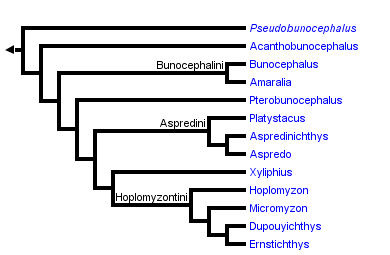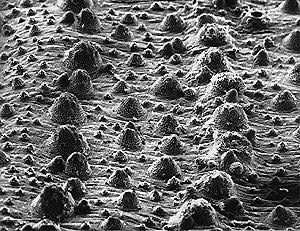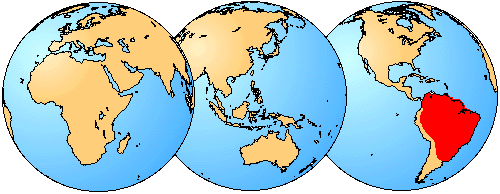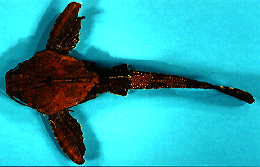Aspredinidae
Banjo Catfishes
John P. Friel


This tree diagram shows the relationships between several groups of organisms.
The root of the current tree connects the organisms featured in this tree to their containing group and the rest of the Tree of Life. The basal branching point in the tree represents the ancestor of the other groups in the tree. This ancestor diversified over time into several descendent subgroups, which are represented as internal nodes and terminal taxa to the right.

You can click on the root to travel down the Tree of Life all the way to the root of all Life, and you can click on the names of descendent subgroups to travel up the Tree of Life all the way to individual species.
For more information on ToL tree formatting, please see Interpreting the Tree or Classification. To learn more about phylogenetic trees, please visit our Phylogenetic Biology pages.
close boxmodified from Friel (1994).
Introduction
The Aspredinidae are known as banjo catfishes due to their overall body shape, a depressed head and slender caudal peduncle which somewhat resembles a banjo. They occur throughout the tropical rivers of South America. Local names for aspredinids include "banjaman" or "banjo-man" (Guyana), "croncron" (French Guiana), "rabeca" (Brazil), and "guitarillo" (Venezuela). Banjo catfishes maybe found in habitats ranging from shallow backwaters to deep river channels to tidal estuaries. In general, most species are cryptically pigmented, benthic and sluggish unless disturbed. Many are semi-fossorial, during the day often resting just beneath the substrate surface.
Approximately 6O extant species of banjo catfishes have been described. A large proportion of these species are now considered subjective junior synonyms of earlier described species. As currently recognized the family contains approximately 35 nominal species placed in 13 genera. In addition there are several undescribed species mostly in the genus Bunocephalus. Despite the relatively small number of species in this family as compared to other catfish families, aspredinids are quite diverse in their morphology. They range from miniature armored species such as Hoplomyzon papillatus, less than 20 mm in length, to large elongate species such as Aspredo aspredo, reaching up to 380 mm in length.
Aspredinids are a highly derived group of catfishes and display some very unusual features. Their skin is completely keratinized and covered with tubercles. Periodically the entire outer layer of skin is shed just like that of amphibians and reptiles (Friel, 1989).


This SEM micrograph shows rows of enlarged tubercles which run longitudinally along the bodies of aspredinids. The light spots covering the tubercles are unicellular keratinized processes called unculi (Roberts, 1982). The horizontal field of view of this image is 1.68 mm.
While aspredinids can swim by typical undulatory movements, they can also use jets of water thrust from their opercular openings to skip along the substrate. When agitated, some species produce audible stridulatory sounds by repeatedly abducting and adducting their pectoral spines.
Very little is known about the general ecology of aspredinids. Based on little published work and personal observation, most aspredinids appear to be generalized omnivores and their stomachs often contain aquatic invertebrates, terrestrial insects and organic debris. One notable exception are members of the genus Amaralia. Based on stomach contents they appear to feed on the eggs of other catfishes (Friel, 1992).
Few specifics are known about reproduction of aspredinids. Parental care is known with certainty in one clade which contains Pterobunocephalus, Platystacus, Aspredo, and Aspredinichthys. Females of this clade carry their developing embryos attached to the ventral surface of their bodies. In Pterobunocephalus, the eggs are directly attached to the body whereas in Platystacus, Aspredo, and Aspredinichthys they are attached to fleshy stalks, called cotylephores, which grow out from the female (Friel, 1994). These develop seasonally and may function in the exchange of materials between the mother and her developing embryos (Wetzel, Wourms, & Friel, 1997).
Discussion of Phylogenetic Relationships
As already mentioned, aspredinids are highly derived catfishes and their monophyly is well supported by many apomorphies. Some of these including: laminar processes of the pterotics directed laterally; vomer absent; mandibular lateralis canal does not enter lower jaw; opercle "L" shaped, resembles a branchiostegal ray; opercular apertures reduced to ventral slits; 5 or fewer branchiostegal rays; dorsal lamina of Weberian complex contacts dorsal surface of body; hemal canal forms de novo by vertebra 7 without a transformation series of rib parapophyses; abdominal vertebral with peg and socket articulations; parapophyses for ribs reduced or absent; 10 or fewer principal caudal-fin rays; expanded bases on outermost caudal-fin rays; muscles on the ventral surface of the pectoral girdle highly reduced or absent; basipterygia without anterior arms; posterior cartilage of basipterygia reduced; mental barbel bases reduced; rows of unculiferous tubercle present on body; and loss of alarm cells & fright reaction. For a complete list of synapomorphies see Friel (1994).
Friel's (1994) phylogenetic revision of the aspredinids revealed that the traditionally recognized subfamily Aspredininae is not the sister group to all other Aspredinidae but is nested higher up in the phylogeny of aspredinids. Furthermore, the subfamily Bunocephalinae sensu Myers (1960), tribe Bunocephalini sensu Myers (1960), Dysichthys sensu Mees (1988, 1989) and Aspredo sensu Mees (1987) are paraphyletic taxa. Major taxonomic and nomenclatural changes are necessitated as a result of this new phylogeny. Species originally placed in Bunocephalus Kner, 1855 and recently transferred to Dysichthys Cope, 1874 by Mees (1988, 1989) are reassigned to Pseudobunocephalus Friel 2008, Pterobunocephalus Fowler, 1943, and Bunocephalus Kner, 1855. In addition, several genera are synonymized. Petacara Böhlke, 1959 is a junior subjective synonym of Pterobunocephalus Fowler, 1943; Dysichthys Cope, 1874 is a junior subjective synonym of Bunocephalus Kner, 1855; and Bunocephalichthys Bleeker 1858 and Agmus Eigenmann, 1910 are junior objective synonyms of Bunocephalus Kner, 1855.
The phylogenetic relationship of the Aspredinidae to other catfishes remains controversial. Prior ideas on relationships are briefly summarized. Günther (1864) first suggested a relationship between the Aspredinidae and a clade containing the Neotropical loricarioids and the Asian Sisoridae. A relationship with loricarioid catfishes was also suggested by Chardon (1968). However Baskin (1972) and Howes (1983) both reviewed Chardon's evidence and concluded that the Aspredinidae are not closely related to loricarioids. Ferraris (1989) suggested that the Asian Akysidae are the sister group to the Aspredinidae. Mo (1991) placed the Aspredinidae either basal to or in a polytomy with a clade containing the Afro-Asian Clariidae, the African Amphiliidae, Neotropical loricarioids, and Asian sisoroids (Amblycipitidae, Akysidae and Sisoridae). Pinna (1993) placed the Aspredinidae in a polytomy with Amblycipitidae, Akysidae, Sisoridae, Amphiliidae and loricarioids. Chen (1994) placed the Aspredinidae as the sister group to Asian sisoroids. More recently, Pinna (1996) now places the Aspredinidae within the currently recognized Asian Sisoridae. Friel (unpublished) reanalyzes all prior evidence presented by others along with new character information and finds two equally parsimonious placements for the Aspredinidae. The sister group to the Aspredinidae are either the Asian sisoroid catfishes as has been suggested by others or the doradoid catfishes (the African Mochokidae, and the Neotropical Doradidae, Centromochlidae and Auchenipteridae). A most recent molecular phylogney (Sullivan et al. 2006) supports the hypothesis that aspredinids are the sistergroup to a clade containing the Neotropical Auchenipteridae and Doradidae.
Geographic Distribution
This Neotropical family of catfishes is found throughout the tropical rivers of South America (Magdalena, Orinoco, Amazon, São Francisco and Paraguay-Paraná), a few rivers west of the Andes (Atrato, San Juan, and Patia) and in brackish and marine waters between the Orinoco and Amazon River deltas.


Key to Genera
- 1a. > 50 anal-fin rays; caudal peduncle with a continuous bony dorsal ridge...2
- 1b. < 20 anal-fin rays; caudal peduncle without a continuous bony dorsal ridge...4
- 2a. 9 principal caudal-fin rays; tubercle rows well developed...Platystacus
- 2b. 10 principal caudal-fin rays; small barbel at base of maxillary barbel present...3
- 3a. Maxillary barbel completely adnate, enlarged humeral process, tubercle rows on body highly reduced; 7 pectoral-fin rays...Aspredo
- 3b. Maxillary barbel not adnate; additional pairs of barbels on ventral surface of body; 8 pectoral-fin rays; antorbitals and mesethmoid with hook-like processes...Aspredinichthys
- 4a. Lower lip equal to upper lip; outermost caudal fin rays shortened; anal and dorsal fins not adnate; lateral line truncated at level of dorsal fin...5
- 4b. Lower lip subequal to upper lip; anal and dorsal fins partially or totally adnate; lateral line complete...6
- 5a. Rigid, locking dorsal spine and spinelet present...Acanthobunocephalus
- 5b. Dorsal spine flexible; no dorsal spinelet...Pseudobunocephalus
- 6a. No obvious bony plates on body...7
- 6b. Dorsal, ventral and lateral series of bony plates present on body...10
- 7a. Lower lip with numerous papillae; no premaxillary teeth...Xyliphius
- 7b. Lower lip without papillae; premaxillary teeth present...8
- 8a. 2-3 dorsal-fin rays; caudal peduncle deep, laterally compressed...Amaralia
- 8b. >4 dorsal-fin rays; caudal peduncle slender, not laterally compressed...9
- 9a. Head and body extremely depressed; skull ornamentation highly reduced or absent, anal-fin with 10 - 20 rays...Pterobunocephalus
- 9b. Head and body deep or moderately depressed; skull ornamentation typically developed; anal fin with 5 - 10 rays...Bunocephalus
- 10a. Papillae present on upper lip; maxillary barbels completely adnate; dentary teeth present; 3 - 4 sets of paired pre-anal-fin plates...Hoplomyzon
- 10b. No papillae present on upper lip; maxillary barbels on slightly adnate; dentary teeth absent; 1 - 2 sets of paired pre-anal-fin plates...11
- 11a. Eyes present; heavily pigmented...12
- 11b. Eyes absent; pigmentation reduced...Micromyzon
- 12a. One set of paired pre-anal-fin plates; pectoral spines only slightly longer than first branched ray; skull ornamentation well developed...Dupouyichthys
- 12b. Two sets of paired pre-anal-fin plates, pectoral spines much longer than first branched ray; skull ornamentation reduced...Ernstichthys
List of Synonymies
| Original Description Name | Current Placement |
| Acanthobunocephalus nicoi Friel, 1995 | Acanthobunocephalus nicoi |
| Agmus lyriformis Eigenmann, 1912b | Bunocephalus verrucosus |
| Aspredinichthys filamentosus Valenciennes, 1840 | Aspredinichthys filamentosus |
| Aspredinichthys tibicen Valenciennes, 1840 | Aspredinichthys tibicen |
| Aspredo aspredo Linnaeus, 1758 | Aspredo aspredo |
| Aspredo batrachus Gronovius, 1854 | Aspredo aspredo |
| Aspredo sexcirrhis Valenciennes, 1840 | Platystacus cotylephorus |
| Aspredo sicuephorus Bleeker, 1858 | Aspredo aspredo |
| Aspredo spectrum Gronovius, 1854 | Platystacus cotylephorus |
| Bunocephalus albifasciatus Fowler, 1943 | Pterobunocephalus depressus |
| Bunocephalus aleuropsis Cope, 1870 | Bunocephalus aleuropsis |
| Bunocephalus amaurus Eigenmann, 1912b | Bunocephalus amaurus |
| Bunocephalus amaurus aloike Hoedeman, 1961 | Bunocephalus amaurus |
| Bunocephalus amaurus sipaliwini Hoedeman, 1961 | Bunocephalus amaurus |
| Bunocephalus bicolor Steindachner, 1882 | Bunocephalus coracoideus |
| Bunocephalus bifidus Eigenmann, 1942 | Pseudobunocephalus bifidus |
| Bunocephalus "boliviensis" Ma, 1977 | Pseudobunocephalus amazonicus |
| Bunocephalus carvalhoi Miranda Ribeiro, 1944 | Pseudobunocephalus iheringii |
| Bunocephalus chamaizelus Eigenmann, 1912b | Bunocephalus chamaizelus |
| Bunocephalus colombianus Eigenmann, 1912a | Bunocephalus colombianus |
| Bunocephalus coracoideus Cope, 1874 | Bunocephalus coracoideus |
| Bunocephalus depressus Haseman, 1911 | Pterobunocephalus depressus |
| Bunocephalus dolichurus Delsman, 1941 | Pterobunocephalus dolichurus |
| Bunocephalus doriae Boulenger, 1902 | Bunocephalus doriae |
| Bunocephalus "dorsolineatus" Ma, 1977 | Pseudobunocephalus sp.? |
| Bunocephalus gronovii Bleeker, 1858 | Bunocephalus verrucosus |
| Bunocephalus haggini Eigenmann & Allen, 1942 | Bunocephalus coracoideus |
| Bunocephalus hypsiurus Kner, 1855 | Amaralia hypsiura |
| Bunocephalus iheringii Boulenger, 1891 | Pseudobunocephalus iheringii |
| Bunocephalus knerii Steindachner, 1882 | Bunocephalus knerii |
| Bunocephalus larai von Ihering, 1930 | Bunocephalus larai |
| Bunocephalus melas Cope, 1874 | Bunocephalus aleuropsis |
| Bunocephalus minutus Güntert, 1942 | Pseudobunocephalus iheringii |
| Bunocephalus retropinnis Eigenmann, 1942 | Bunocephalus doriae |
| Bunocephalus rugosus Eigenmann & Kennedy, 1903 | Pseudobunocephalus rugosus |
| Bunocephalus salathei Myers, 1927 | Pseudobunocephlaus iheringii |
| Bunocephalus scabriceps Eigenmann & Eigenmann, 1889 | Bunocephalus verrucosus |
| Bunocephalus "spieleri" Ma, 1977 | Pseudobunocephalus sp.? |
| Cotylephorus blochii Swainson, 1838 | Platystacus cotylephorus |
| Dupouyichthys sapito Schultz, 1944 | Dupouyichthys sapito |
| Dysichthys amazonicus Mees, 1989 | Pseudobunocephalus amazonicus |
| Dysichthys australe Eigenmann & Ward, 1907 | Pseudobunocephalus rugosus |
| Dysichthys quadriradiatus Mees, 1989 | Pseudobunocephalus quadriradiatus |
| Ernstichthys anduzei Fernández-Yépez, 1953 | Ernstichthys anduzei |
| Ernstichthys intonsus Stewart, 1985 | Ernstichthys intonsus |
| Hoplomyzon megistus Orcés, 1961 | Ernstichthys megistus |
| Hoplomyzon atrizona Myers, 1942 | Hoplomyzon atrizona |
| Hoplomyzon atrizona petroleus Schultz, 1944 | Hoplomyzon atrizona |
| Hoplomyzon papillatus Stewart, 1985 | Hoplomyzon papillatus |
| Hoplomyzon sexpapillostoma Taphorn & Marrero, 1990 | Hoplomyzon sexpapilostoma |
| Micromyzon akamai Friel & Lundberg, 1996 | Micromyzon akamai |
| Platystacus cotylephorus Bloch, 1794 | Platystacus cotylephorus |
| Platystacus laevis Bloch, 1794 | Aspredo aspredo |
| Platystacus nematophorus Bleeker, 1862 | Platystacus cotylephorus |
| Platystacus verrucosus Bloch, 1794 | Bunocephalus verrucosus |
| Pseudobuncephalus lundbergi Friel 2008 | Pseudobuncephalus lundbergi |
| Siluris hexdactylus La Cepede, 1803 | Platystacus cotylephorus |
| Siluris verrucosus Walbaum, 1792 | Bunocephalus verrucosus |
| Xyliphius barbatus de Arámburu & Arámburu, 1962 | Xyliphius barbatus |
| Xyliphius kryptos Taphorn & Lilyestrom, 1983 | Xyliphius kryptos |
| Xyliphius lepturus Orcés, 1962 | Xyliphius lepturus |
| Xyliphius lombarderoi Risso & Risso, 1964 | Xyliphius lombarderoi |
| Xyliphius magdalenae Eigenmann, 1912a | Xyliphius magdalenae |
| Xyliphius melanopterus Orcés, 1962 | Xyliphius melanopterus |
References
Baskin, J. N. 1972. Structure and relationships of the Trichomycteridae. Ph.D. thesis, City University of New York, XXI + 389 pp.
Böhlke, J. E. 1959. Results of the Catherwood Foundation Peruvian Amazon expedition. Petacara, a new genus for the bunocephalid catfish, Bunocephalus dolichurus Delsman. Notulae Naturae, 318: 1-6.
Chardon, M. 1968. Anatomie comparée de l'appareil de Weber et des structures connexes chez les Siluriformes. Annales de Muse Royale de l'Afrique Centrale, Ser. 8, Sciences Zoologiques, 169: 1-227.
Chen, X. 1994. Phylogenetic studies of the amblycipitid catfishes (Teleostei, Siluriformes) with species accounts. Ph.D. thesis, Duke University, XX + 471 pp.
Cope, E. D. 1874. On some Batrachia and Nematognathi brought back from the upper Amazon by Prof. Orton. Proceedings of the Academy of Natural Sciences of Philadelphia, 120-137.
Eigenmann, C. H. 1910. Catalogue of the fresh-water fishes of tropical and South America. Reports of the Princeton University Expeditions to Patagonia, 1896-1899, 3(2):375-484.
Ferraris, C. 1989. On the interrelationships between the Aspredinidae and the Akysidae (Ostariophysi, Siluriformes). Abstracts of the 1989 Annual Meeting of the American Society of Ichthyologists and Herpetologists at San Francisco StateUniversity, p. 86.
Fowler, H. W. 1943. Zoological results of the second Bolivian expedition for the Academy of Natural Sciences of Philadelphia 1936-1937. Part II. - Additional new fishes. Notulae Naturae,(120): 1-7.
Friel, J. P. 1989. Epidermal keratinization and molting in the banjo catfishes (Siluriformes: Aspredinidae). Abstracts of the 1989 Annual Meeting of the American Society of Ichthyologists and Herpetologists at San Francisco State University, p. 89.
Friel, J. P. 1992. A phylogenetic revision of Amaralia, a genus of oophagous banjo catfishes. Abstracts of the 1992 Annual Meeting of the American Society of Ichthyologists and Herpetologists at the University of Illinois at Urbana-Champaign, p. 104.
Friel, J. P. 1994. A phylogenetic study of the Neotropical banjo catfishes (Teleostei: Siluriformes: Aspredinidae) Ph.D.thesis, Duke University, Durham, NC, 256 pp.
Friel, J. P. 1995. Acanthobunocephalus nicoi, a new genus and species of miniature banjo-catfish from the upper Orinoco and Casiquiare Rivers, Venezuela. (Siluriformes: Aspredinidae). Ichthyological Explorations of Freshwaters, 6(1): 89-95.
Friel, J. P. 2008. Pseudobunocephalus, a new genus of banjo catfish with the description of a new species from the Orinoco River system of Colombia and Venezuela (Siluriformes: Aspredinidae). Neotropical Ichthyology, 6(3):293-300.
Friel, J. P. & Lundberg, J. G. 1996. Micromyzon akamai, gen. et sp. nov., a small and eyeless banjo catfish (Siluriformes: Aspredinidae) from the river channels of the lower Amazon basin. Copeia, 1996(3): 641-648.
Günther, A. 1864. Catalogue of the Physostomi, containingthe families Siluridae, Characinidae, Haplochitonidae, Sternoptychidae, Scopelidae, Stomiatidae in the collection of the British Museum. Vol. 5, British Museum, London, XXII+ 455 pp.
Howes, G. J. 1983. The cranial muscles of loricarioid catfishes, their homologies and value as taxonomic characters (Teleostei: Siluroidei). Bulletin of the British Museum of Natural History, (Zoology), 45(6): 309-345.
Kner, R. 1855 . Ichthyologische Beiträge. I. Über die Gattungen Aspredo und Chaca C. V. aus der Familie der Welse (Siluroidei). Sitzungsberichte der Mathematisch- Naturwissenschaftlichen Classe der Kaiserlichen Akademie der Wissenschaften, 8: 92-105.
Mees, G. F. 1987. The members of the subfamily Aspredininae, family Aspredinidae in Suriname (Pisces, Nematognathi). Proceedings of the Koninklijke Nederlandse Akademie van Wetenschappen, 90(2): 173-192.
Mees, G. F. 1988. The genera of the subfamily Bunocephalinae (Pisces, Nematognathi, Aspredinidae). Proceedings of the Koninklijke Nederlandse Akademie van Wetenschappen, 91(1):85-102.
Mees, G. F. 1989. Notes on the genus Dysichthys, subfamily Bunocephalinae, family Aspredinidae (Pisces, Nematognathi). Proceedings of the Koninklijke Nederlandse Akademie van Wetenschappen, 92(2): 189-250.
Mo, T. 1991. Anatomy, relationships and systematics of the Bagridae (Teleostei: Siluroidei) with a hypothesis of siluroid phylogeny. Theses Zoologicae 17, Koeltz Scientific Books, Koenigstein, vii + 216 pp., 63 figs.
Myers, G. S. 1960. The genera and ecological geography of the South American banjo catfishes, family Aspredinidae. Stanford Ichthyological Bulletin, 7(4): 132-139.
Pinna, M. C. C. 1993. Higher-level phylogeny of Siluriformes, with a new classification of the order (Teleostei, Ostariophysi). Ph.D. thesis, The City University of New York,xi + 482 pp.
Pinna, M. C. C. 1996. A phylogenetic analysis of the Asian catfish families Sisoridae, Akysidae and Amblycipitidae, with a hypothesis on the relationships of the neotropical Aspredindae (Teleostei, Ostariophysi). Fieldiana. No. 4:1-83.
Sullivan, J. P., Lundberg, J. G. and Hardman, M.. 2006. A phylogenetic analysis of the major groups of catfishes (Teleostei: Siluriformes) using rag1 and rag2 nuclear gene sequences, Molecular Phylogenetics and Evolution, 41(3): 636-662.
Wetzel, J., Wourms, J. and Friel, J. 1977. Modifications of the skin epidermis in the skin-brooding catfish, Platystacus cotylephorus. Environmental Biology of Fishes 50(1):13-25.
Title Illustrations

| Scientific Name | Bunocephalus coracoideus |
|---|---|
| Image Use |
 This media file is licensed under the Creative Commons Attribution-NonCommercial License - Version 3.0. This media file is licensed under the Creative Commons Attribution-NonCommercial License - Version 3.0.
|
| Copyright |
© 1995 John P. Friel

|
About This Page
John P. Friel

Cornell University Museum of Vertebrates, Ithaca, New York, USA
Page copyright © 2009 John P. Friel
 Page: Tree of Life
Aspredinidae. Banjo Catfishes.
Authored by
John P. Friel.
The TEXT of this page is licensed under the
Creative Commons Attribution License - Version 3.0. Note that images and other media
featured on this page are each governed by their own license, and they may or may not be available
for reuse. Click on an image or a media link to access the media data window, which provides the
relevant licensing information. For the general terms and conditions of ToL material reuse and
redistribution, please see the Tree of Life Copyright
Policies.
Page: Tree of Life
Aspredinidae. Banjo Catfishes.
Authored by
John P. Friel.
The TEXT of this page is licensed under the
Creative Commons Attribution License - Version 3.0. Note that images and other media
featured on this page are each governed by their own license, and they may or may not be available
for reuse. Click on an image or a media link to access the media data window, which provides the
relevant licensing information. For the general terms and conditions of ToL material reuse and
redistribution, please see the Tree of Life Copyright
Policies.
- First online 05 July 1995
- Content changed 02 March 2009
Citing this page:
Friel, John P. 2009. Aspredinidae. Banjo Catfishes. Version 02 March 2009 (under construction). http://tolweb.org/Aspredinidae/15208/2009.03.02 in The Tree of Life Web Project, http://tolweb.org/







 Go to quick links
Go to quick search
Go to navigation for this section of the ToL site
Go to detailed links for the ToL site
Go to quick links
Go to quick search
Go to navigation for this section of the ToL site
Go to detailed links for the ToL site